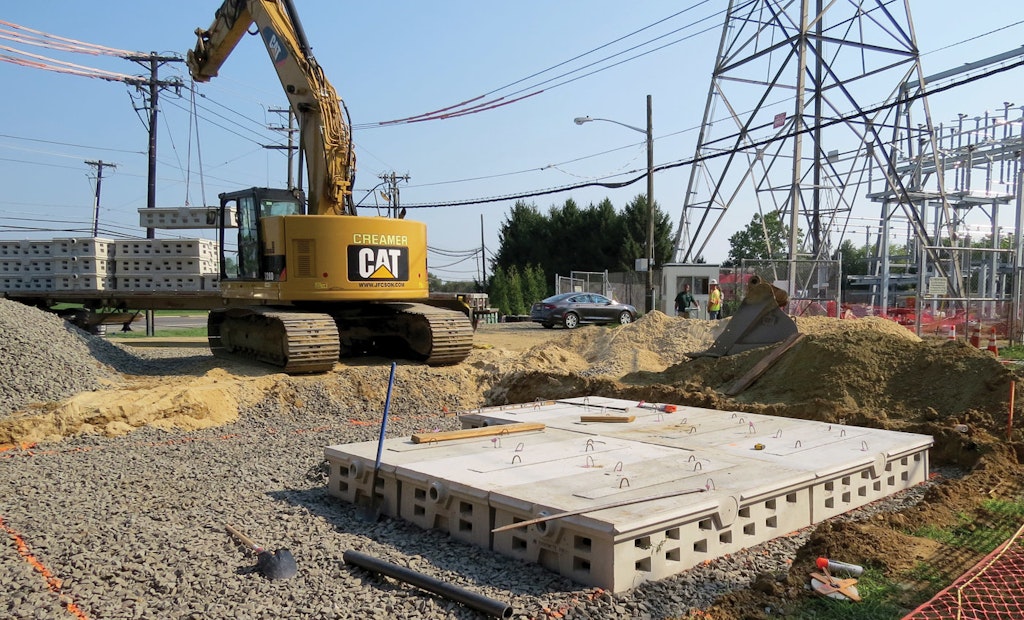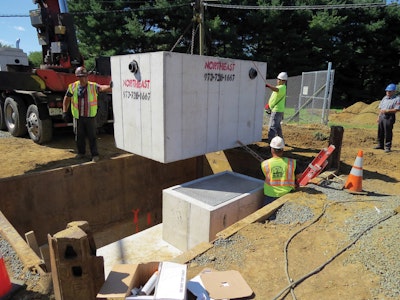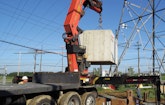
Interested in Septic Tanks?
Get Septic Tanks articles, news and videos right in your inbox! Sign up now.
Septic Tanks + Get AlertsPublic Service Electric and Gas Co. (PSE&G) was upgrading its 230 kV Lumberton substation in Mount Holly, New Jersey. The control house, normally staffed by two people, had a small lavatory, but its onsite system had been removed in preparation for the expansion. The only available location for a replacement drainfield was a grassy area used for emergency parking.
The utility hired designer Doug Fine, P.E., of Fine Engineering in Three Bridges, New Jersey, noted for solving spatial issues with green technology. “The challenge was to make the space usable for parking and effluent disposal,” says Fine. For suggestions, he turned to Joe Mayers of Septic Experts in Augusta, New Jersey.
Thirty years ago, Mayers had installed H-20 traffic-rated septic components. Drawing on his experience, he recommended H-20 concrete flow diffusers for the drainfield and an Ecoflo Coco Filter three-in-one treatment unit (Premier Aqua Tech) in an H-20 concrete tank. “The media in the Ecoflo is fragmented coconut husks, a renewable resource,” he says.
The system, one of the first of its kind in the state, was one of Mayers’ most dangerous locations. “The tanks were 8 feet from the leg of a 230 kV steel-lattice transmission line tower,” he says. “I had power humming over my head, passing under my feet, and emanating from tractor-trailer generator sets on the side. It made me nervous.”
Site conditions
Soils are loamy sand with a loading rate of 12 minutes per inch and a seasonal high water table 6 feet below grade.
System components
- Fine designed the system to handle 650 gpd. All components are H-20 rated with Schedule 80 PVC piping.
- 1,000-gallon, single-compartment monolithic concrete septic tank (Northeast Concrete)
- PL625 effluent filter (Polylok)
- Ecoflo Coco Filter (Premier Tech Aqua)
- Customized distribution box with baffle (Northeast Concrete)
- 18 type “L” (long end entry) flow diffusers (J.B. Concrete Products)
- Alarm system (Ecoflo package)
System operation
Wastewater flows 96 feet through a 4-inch lateral from the control house to the septic tank and Ecoflo set in series. Inside the ATU, more solids settle out in the trash tank before gravity delivers effluent to a tipping bucket, which evenly distributes it over plates with channels and orifices. Liquid trickling down through the media collects at the bottom of the unit, then flows to the pump vault.
When activated, the on-demand pump in the vault cycles about two minutes, sending effluent 93 feet through a 2-inch force main to the distribution box. Dedicated 4-inch supply lines feed six rows of three diffusers in the 28- by 29-foot drainfield. The pipes, entering the side of the chambers 3 inches from the top, discharge into a 4-inch-diameter monolithic precast channel 8 feet long with 3/8-inch slots.
Effluent drips through the slots into the stone and sand bed. Two rows of six 5- by 2-inch-wide drain holes in the sides of the chambers allow effluent to move laterally as the water level rises. However, a biomat should not form after tertiary treatment. Premier Tech Aqua reports that independent tests show effluent averages 6 to 8 mg/L TSS, 7 to 3 mg/L BOD, 11 to 13 mg/L TKN, and 10 to 11 mg/L ammonia.
Tank installation
Mayers collaborated with PSE&G’s contractor, J. Fletcher Creamer & Son, to install the system. He was classified as an installation consultant by the utility and, as a Premier Tech Aqua certified installer, was the only one authorized to show the four workers where to place and how to assemble the components. PSE&G allowed Mayers to plumb the Ecoflo and install the pump.
A safety training course through the utility enabled Mayers and Fine to walk around the yard. “Safety was paramount, and there was a safety meeting every morning,” says Mayers. “The course taught us not to lift anything above our waists, not to hold metal objects in our hands, and to stay in our work area. We needed special boots and a special hard hat, because electricity could follow the steam trail from a vented hat to the owner’s head.”
A security fence with one gate enclosed the massive facility. The tanks were inside the fence, the distribution box and drainfield outside it. The yard teemed with multiple contractor crews and machinery, which was grounded to a subsurface grid with a cable every 15 feet.
Creamer’s 328D Caterpillar excavator was too wide to pass through the gate, so PSE&G removed a section of fence, enabling his crew to dig and shore the hole for the tanks. Meanwhile, John Vitale, owner of Northeast Concrete Products, loaded the 10- by 6-foot-square tank for the Ecoflo, the 9- by 6-foot-square steel reinforced septic tank, and the distribution box on his flatbed truck.
Three hours and 113 miles later, Vitale joined the queue of vehicles waiting to clear the gate. Once there, he waited for the ground worker and safety worker. When the pair arrived, the ground worker connected and disconnected grounding cables until Vitale had backed the truck near the hole. Then the safety worker ensured the truck was set properly and grounded. As Vitale set the tanks with a Palfinger PK 72002 crane, the safety worker watched the distance between it and the power lines. Creamer’s dump truck removing spoil went through an identical process.
An 18- by 18-foot by 8-inch-thick concrete slab reinforced with double layers of 4- by 4-gauge welded wire fabric covered both tanks. Creamer’s crew cast it on-site, and recessed the H-20 aluminum hatch 3/8 inch to protect it from snow plows. Then a PSE&G official asked Mayers to seal the tank tops with tar. “It was an afterthought by their engineers,” he says. “The hatch has a weep hole discharging down the side of the inlet riser. Without the tar, dissolved road salt in melting snow would drip on the concrete and erode it.”
Drainfield installation
Tank work (including connecting the lateral from the control house to the septic tank) and backfilling took a day. The next morning, workers excavated the 3-foot-deep force main trench running outside the fence, and the 5.5-foot-deep drainfield. Dump trucks filled the hole with 4.5 feet of C-33 concrete sand and 12 inches of 1.5-inch crushed, washed stone, and hauled away spoil.
Meanwhile, owner John Barnes of J.B. Concrete Products drove his flatbed tractor-trailer 244 miles from Putnam, Connecticut, to deliver the 8- by 4- by 1.5-foot-high diffusers. Creamer’s excavator operator set the 2,360-pound units.
“The chambers have tongue-and-groove ends and sides that lock them into one consecutive block,” says Mayers. “The men used shovels and a 6-foot-long steel bar to muscle the chambers into position as the machine operator lowered them the last few inches. He had to work in two different planes to ensure the tongue and grooves mated.” Lids on the chambers serve as inspection ports.
After workers set a 9.5-foot-long 4-inch Schedule 40 PVC monitoring well in one corner of the drainfield, they backfilled with stone. The 2-inch force main from the Ecoflo to the distribution box ran under the entrance gate, and was installed last to keep the road open for as long as possible. The project took 10 days, including spreading topsoil and grass seed.
Maintenance
Premier Tech Aqua maintains the service contract. The system is inspected every six months for the first two years, then annually.









